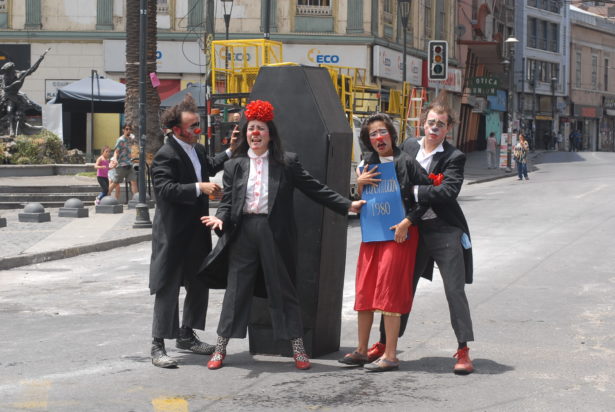
On the surface, things have calmed down in Chile, after the initial weeks of massive demonstrations that began on Oct. 18, and brought the military back into the streets almost three decades after the fall of Gen. Augusto Pinochet. But the country is far from calm.
While new repressive tactics are being used to keep stubborn protesters away from the now legendary Dignity Square, the Chilean people — from organized traditional unions to artist collectives — are developing and implementing new creative nonviolent direct actions. The best known among them is the now world famous performance of the Las Tesis women’s collective that spread like wildfire from Valparaiso to Istanbul to Mexico City to San Francisco and beyond.
What is it that has kept the fire of protest alive? How are Chileans dealing with the wounds inflicted on thousands and how are they seeking to overcome fear?
Constanza Salcedo is only 25 years old. On Oct. 19, she joined neighbors protesting in the La Florida neighborhood of Santiago to nonviolently defy the curfew that had begun that day, the first of a week long state of emergency. It only took a few minutes for the Carabineros (local police) to shoot at her and change her life forever. She was to be become the first to lose her eyesight as a result of police violence. Since then, 316 other people have suffered eye injuries and 21 of them have suffered irreversible damage.
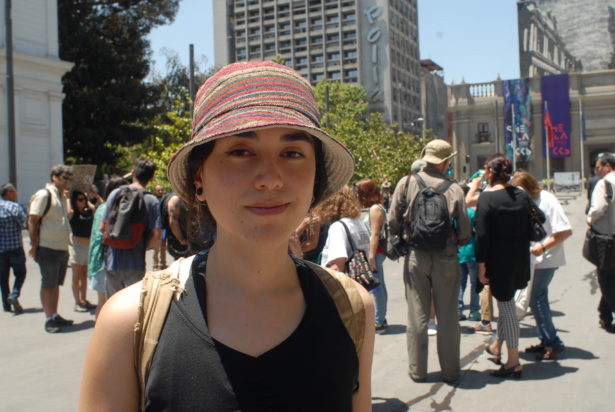
“I have not lost my eye: I still have the eyeball, but I have completely lost vision,” she said calmly, before adding: “Fortunately it wasn’t both, as was the case with Gustavo Gatica or Fabiola Campillay.”
Salcedo’s feelings have kept changing since that tragic day. “At first I was very angry and sad,” she said. “I couldn’t believe that someone would have shot to show his superiority, to obey orders. The truth is I still cannot understand. They want to provoke permanent damage and that hurts me a lot. You lose some faith in humanity.”
But Salcedo has kept living, studying and organizing. Only three days before we spoke she had graduated from the University of Chile as a midwife, and when we met she was marching with the recently organized Coordinating Committee of Victims of Eye Injuries.
“Now I am trying to deal with all this,” she said. “That is why I get involved in this. I am not a very extroverted person, but I know that this helps people be aware about what is going on.”
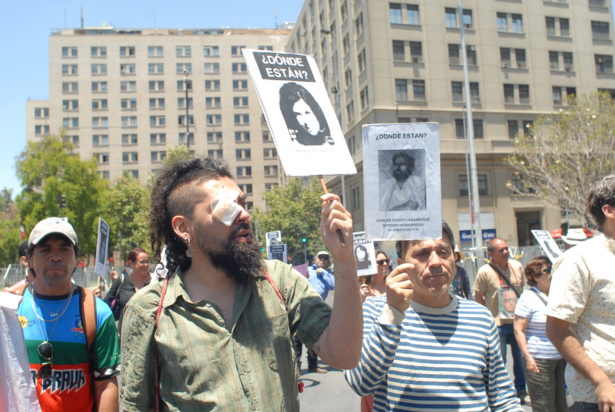
Dec. 20 marked the first time that the newly formed Coordinating Committee of Victims of Eye Injuries marched alongside the relatives of the disappeared, who have been marching at least since 1978, seeking the whereabouts of more than a thousand people who never returned after being captured by police following the 1973 military coup. After the return to formal democracy in 1990 they have marched many Fridays (some 160 times) between the presidential palace and the Supreme Court.
The fact that both groups marched together made it possible for the new committee to walk the few blocks without being repressed by the police. The traditional signs showing the faces of the disappeared were now accompanied by signs showing bleeding eyes carried by protesters, some of whom covered their own injured eyes. Drawings of eyes as art objects and the covering of one eye in public have become the symbol of police repression.
Among those who marched that Friday was Marta Valdés Recabarren, whose 17-year-old son Edgardo Navarro Valdés was shot in the face by a policeman during a high school demonstration. As a result, he suffered a serious eye injury that has prevented him from being on the frontlines of the protests and from practicing skating, which is another passion. His mother, after realizing that many did not know how to seek help — and that others offering support couldn’t find ways to channel their efforts — got together with 20 eye injury victims and organized the group.
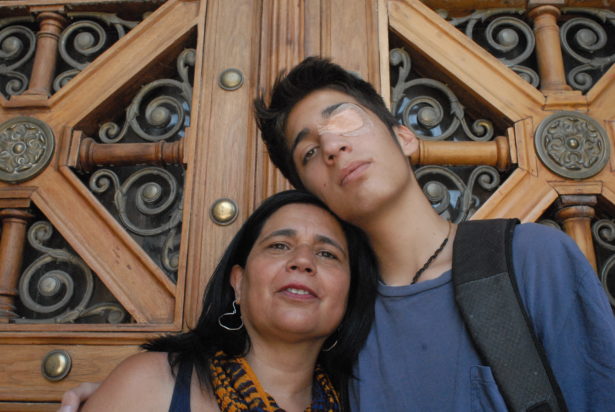
“Psychologically, and in many other aspects, it has been of great help to be united, to be together,” said Marta, who now acts as the spokesperson for the committee. “From sorrow we have come out with something beautiful: to know each other, to love each other, to caress each other, to share our pain and see how we are coping with the eye injuries. This has been of tremendous significance in a country today immersed in so much violence.”
Despite not being new to this violence, like other victims, she remains hopeful.
“I have five disappeared in the family” she said in an almost casual way, referring to the brothers, father and wife of the Gonzalez Recabarren family who were kidnapped in the 1970s. “The best way we can get even with those who have repressed, who have tortured, for all they have done, is to be happy. And I am cheerful, regardless of everything that we have lived through.”
The committee is working on providing medical help to those injured across the country and also preparing a legal case against President Sebastián Piñera, who they believe is ultimately responsible for the repression. That case will at some point be seen by the Supreme Court, the exact place where the committee ended their march.
Re-vindicating nonviolent civil disobedience
The judicial system is in fact a key player in current events in Chile. Their main headquarters in Santiago is right across the street from the parliament. And it was precisely this space that Unidad Social, or Social Unity, the main coalition of traditional unions and social movements supporting the protests, decided to occupy in what they called Dignity Camp. Starting on Dec. 9, they came with tents, stages and sound systems, and for 11 days held public meetings, lectures and artistic performances concerning many issues, among them of course the new constitutional process that will be decided next April. For Mario Aguilar, head of the powerful teachers union, it was a re-vindication of a legitimate course of action.
“Our main goal was to carry out an act of civil disobedience at a time when they have tried to demonize civil disobedience almost as an act of terrorism,” explained Aguilar on the teachers union’s online video channel. “We re-vindicate the right of the people to carry out nonviolent civil disobedience. Civil disobedience is a profoundly ethical act; it is fundamentally a moral act.”
The occupation was illegal because they were not given permits to create the democratic space to debate what Chileans want for their country legally, he explained. “[It is] an illegal, but profoundly democratic action, just as there are actions that are legal, but profoundly antidemocratic and illegitimate” he added, before pointing to the offices of the Supreme Court and Parliament.
Congress indeed has been slow in introducing changes to the process for a new constitution that is scheduled to begin with the plebiscite in late April. A preliminary agreement has been reached to have a quota system to assure equal representation for women, but disagreement remains concerning reserving quotas for indigenous representatives. Urgent social reforms demanded by the uprising that began on Oct. 18 have also not been implemented. These include an end to the privatized pension system put in place during the Pinochet dictatorship that has failed to cover basic costs of living for the great majority of retirees, and access to free health and education.
Previous Coverage
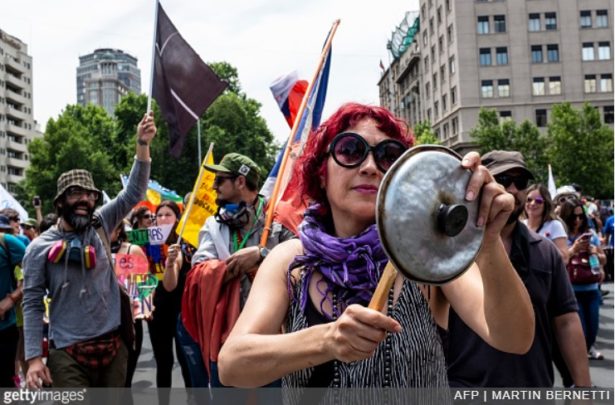 What happened when Chile woke up
What happened when Chile woke upCourts on the other hand have been slow to react to the widespread human rights abuses that, despite decreasing in number, have continued. Indeed, in November and December four major international human rights organizations — the Office of the U.N. High Commissioner for Human Rights, Inter-American Commission on Human Rights, Amnesty International and Human Rights Watch — put out statements or reports denouncing widespread and systematic human rights abuses, many of which are ongoing.
Some national courts have in fact been slowly restoring some basic rights. Judge Daniel Urrutia, for example, ruled that it was illegal for the city and police to prevent protesters from gathering at Dignity Square. And on Dec. 23, the Santiago Appeal Court released math teacher Roberto Campos, the first person arrested for the still unresolved destruction of 25 subway stations between Oct. 17 and 18. Charged with destruction of subway installations (allegedly proven by subway surveillance videos) and violation of Internal Security laws, Campos had been held at a maximum security prison and today awaits trial at his Santiago home.
A couple dozen protesters who had come to support Campos celebrated outside the courthouse after the judges reviewed the case. Armando Arjona, Campos’ Mexican-born partner, highlighted the importance of the ruling.
“I am supremely thankful. Not only are we bringing about social changes, but also political ones,” he said. “Justice belongs to the people [and is] in our hands. We have been able to change the history of Chile, and we can change the way that justice is implemented. This has not ended. There are still many compañeros and compañeras imprisoned because of the mobilizations.”
On the following day a court in the southern city of Concepción released three students who were also held in prison awaiting trial.
According to the prosecutor’s office, there are 1,957 people held in prison awaiting trial and 20,207 people have been indicted, most of them for theft in uninhabited locations.
Furthermore, on Jan. 8 the government announced legal prosecutions against high school student leaders, responsible for sparking the widespread protests, and who recently occupied public schools in an effort to boycott what they claim are unfair college entrance examinations.
On the other hand, only a handful of members of the security forces are being held in prison, despite the prosecutor’s office having opened 2,670 investigations for human rights violations. Among them are dozens of cases of sexual violence. In November 2019, the governmental (but independent) National Human Rights Institute presented 74 legal actions for sexual violence, a figure that amounted to four times those presented in the last nine years combined.
Reinventing barricades
It was precisely this aspect of repression that led Las Tesis to come up with a feminist dance performance known as “A rapist in your way.” It has been reenacted by groups of women in a variety of public spaces, among them Chile’s main sport arena, where thousands of women of all ages simultaneously moved their bodies, pointed their fingers and blasted patriarchy in its various forms — from state violence to daily sexism — with lyrics that defy and inspire.
“The rapist is you. It’s the cops, the judges, the state, the president. The oppressive state is a macho rapist,” the participants cry out in unison. “And the fault wasn’t mine, not where I was, not how I dressed. The rapist was you. The rapist is you.”
After the group first performed on Nov. 20 in front of a police station in Valparaiso, it spread quickly around the world. It is not only a powerful denunciation of the sexist violence of the police and the state as a whole, but also an example of the many art actions that have begun replacing traditional barricades with performances on street corners and in shopping malls. Sparked by small artist collectives, these regular street performances are decentralized and spontaneous.
The artists who constitute the group “Fire: Actions in Cement” inspired the Las Tesis collective to come up with their now legendary action.
“We were out in the streets, participating in the protests since the first day, for at least the first three weeks,” said Andrés Ulloa, one of the members of Fire, who is an actor and teacher from Valparaiso. “But there came a time when the police changed their strategies of repression, and it became much more difficult for us to be in the protests. We are not that young anymore. It was saying to ourselves, ‘We are afraid, but we cannot remain in the margins, we have to act.’”
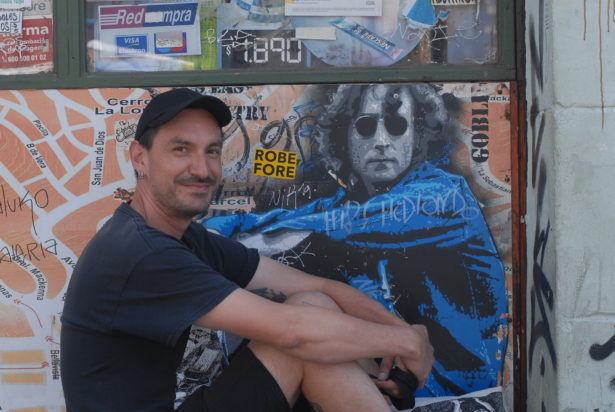
It all began on Nov. 9, when Katty Lopez posted a call to fellow artists on her Facebook page.
“I suppose it’s key to carry out actions that rub the faces of those who for years have inflicted miseries and pain on us, but I also see, even more urgently, a revolution with laughter, dissidence, joy, dance, pleasure,” the post read in part. “Make the streets become improvised theaters, make the streets become intimacy, make the streets become inextinguishable force and fire.”
Close to a hundred people responded, and Lopez, Ulloa and three others, decided to give form to the original idea.
“And we named it Fire to symbolize the social movement and the explosion that has resulted in a fire that has not been extinguished, and action on cement because what we proposed was to act in the streets and occupy public spaces,” Ulloa recalled.
They came up with three types of actions: “scenic barricades” consist of blocking street traffic for no more than five minutes and performing a short theatrical piece. Another type of action they call “facades,” which involve artists performing brief plays where they talk back and forth with the institution represented by the facade. They have performed these action in front of the courts and a local church. The third kind of action is “outside the theater,” where short plays are performed in squares and other public spaces.
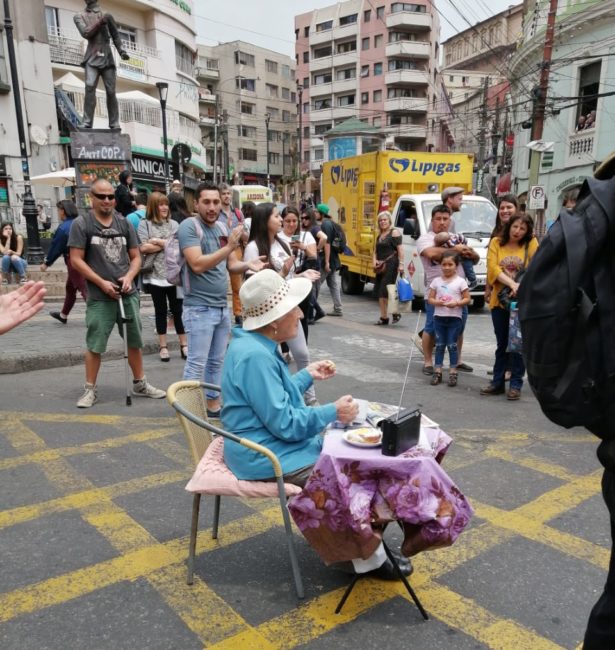
The first scenic barricade, the most successful of their proposals, featured the grandmother of an artist who blocked the streets and calmly had a cup of tea, as a denunciation of the miserable conditions of many elderly people. Images of the performance went viral and the actions multiplied. The third was the one organized by Las Tesis, but dozens have occurred since. On New Years Eve for example 10 simultaneous scenic barricades took place, mostly by actors, but also one by a graphic artists collective.
Fire: Action on Cement has helped produced many of the events, but they do not seek to become permanent coordinators nor owners of the idea.
“Our proposal is that this function in a joint and collaborative manner,” added an inspired actor after yet another successful barricade at the Anibal Pinto square on Dec. 28. “The idea is for people to grab the idea and apply it independently. The bottom line is that we don’t want to direct anything … which is part of the spirit of the revolt … We will keep disrupting traffic even though it might bother some people, because we believe it is necessary.”
Some 10,000 people gathered to welcome New Year in Santiago, despite not having a permit. Special tables were set up and food given to members of voluntary health brigades and others on the frontlines. However, as the street celebrations came to an end, two more Chileans — Matias Orellana, a teacher from Valparaiso, and Diego Lastra, a medical student from Santiago — were both partially blinded by tear gas canisters shot in their faces by the police.
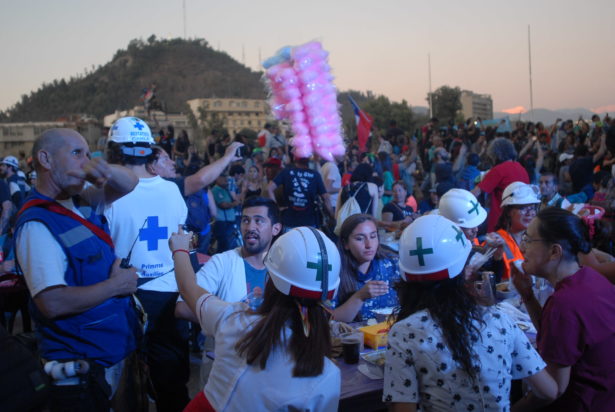
Others, such as a young couple, were heavily repressed by the police. Judith Fernandez, a protester who was badly beaten with her partner Eduardo Hidalgo near Dignity Square, sent a public message on social media. Speaking with her eyes swollen by the police beating, Fernandez came close to tears when she recalled the help she had received from health volunteers.
“Two wonderful people gave us drops that helped with the most intense pain,” she said passionately. “They were there supporting us, even though they didn’t know us — encouraging us, thanking us for having been there. Let’s continue. This is not going to stop. No beating, no mark that these assholes leave on our bodies is going to fracture our spirit. We are winning, we are going to make it.”

This is such a great, informative article. Thank you to Cristian Opaso. This exemplifies the type of coverage I love from Waging Nonviolence.